Explore the must-have CRM features for universities in 2025 that streamline admissions, boost student engagement, improve retention rates, and enhance communication across the student lifecycle—helping institutions stay competitive, efficient, and student-focused in a rapidly evolving education landscape.
Table Of Contents
Introduction
The higher education landscape is undergoing rapid evolution. Institutions are under immense pressure to not only attract new students but also to retain and engage them throughout their academic journey. The global higher-education CRM software market, valued at approximately USD 2.8 billion in 2024, is projected to grow to USD 3.3 billion in 2025, eventually reaching USD 10.8 billion by 2033—a remarkable CAGR of 15.9%.
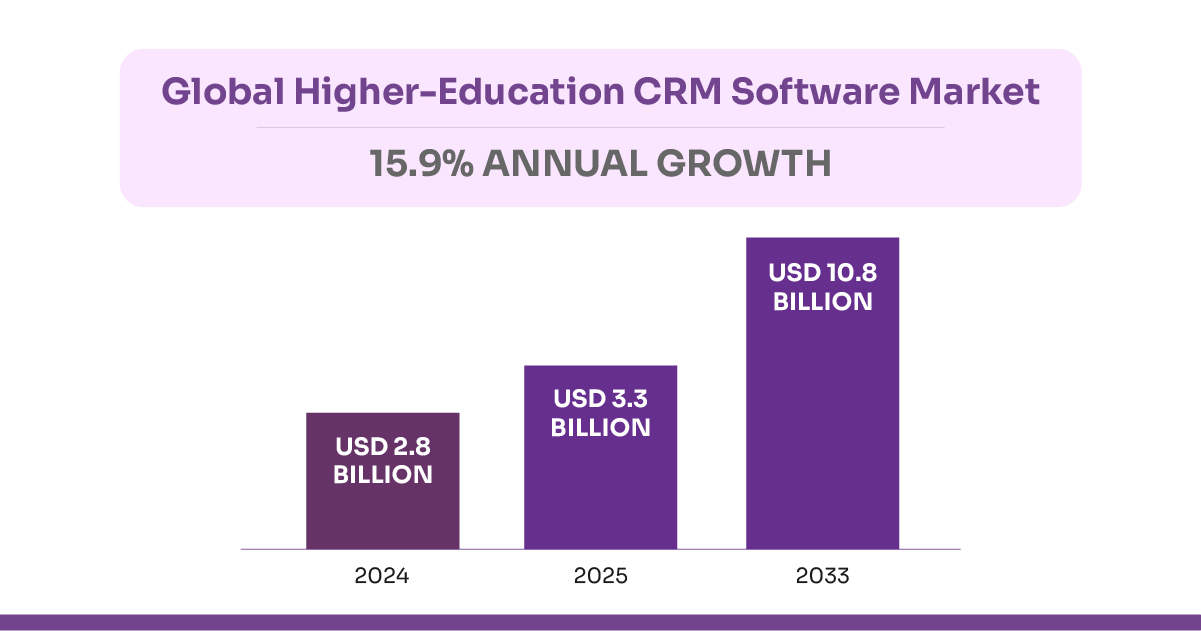
Nearly 30% of first-year students at U.S. baccalaureate institutions do not return for their sophomore year, resulting in an annual cost of around USD 9 billion.
With rising tuition fees and increasing competition, institutions cannot afford inefficiencies or poor student experience. A modern CRM system becomes an essential institutional backbone by enabling the following:
Personalised, holistically guided student journeys supported by AI-driven insights.
- A 36% increase in student retention
- A 25% faster response time to inquiries
- A 20–30% improvement in operational efficiency
CRMs are no longer just for admissions. They span across:
- Lead nurturing, improving application-to-enrollment conversion by over 20–23%.
- Alumni engagement has led to institutions experiencing a 20% increase in alumni donations.
Let’s explore some universities that have utilised CRM features to enhance their enrollment:
- Georgia State University (GSU)
- LSU Online (Louisiana State University)
- Southern New Hampshire University (SNHU)
- Purdue University Global
- University of Texas at Austin
In this blog, we’ll break down the top 10 must-have features that every university CRM should include in 2025 to stay competitive, student-centric, and operationally efficient.
Why Does a University Need a CRM in 2025?
In 2025, universities face unprecedented challenges — and equally massive opportunities. With enrollment declining, competition intensifying, and student expectations rising, institutions need more than just traditional software systems. They need a smart, centralised CRM (Customer Relationship Management system) built for the unique demands of modern higher education.
Modern students are digital-first. A Salesforce.org report reveals that 76% of students (customers) expect consistent interactions across departments, while 66% expect systems to understand their personal needs.
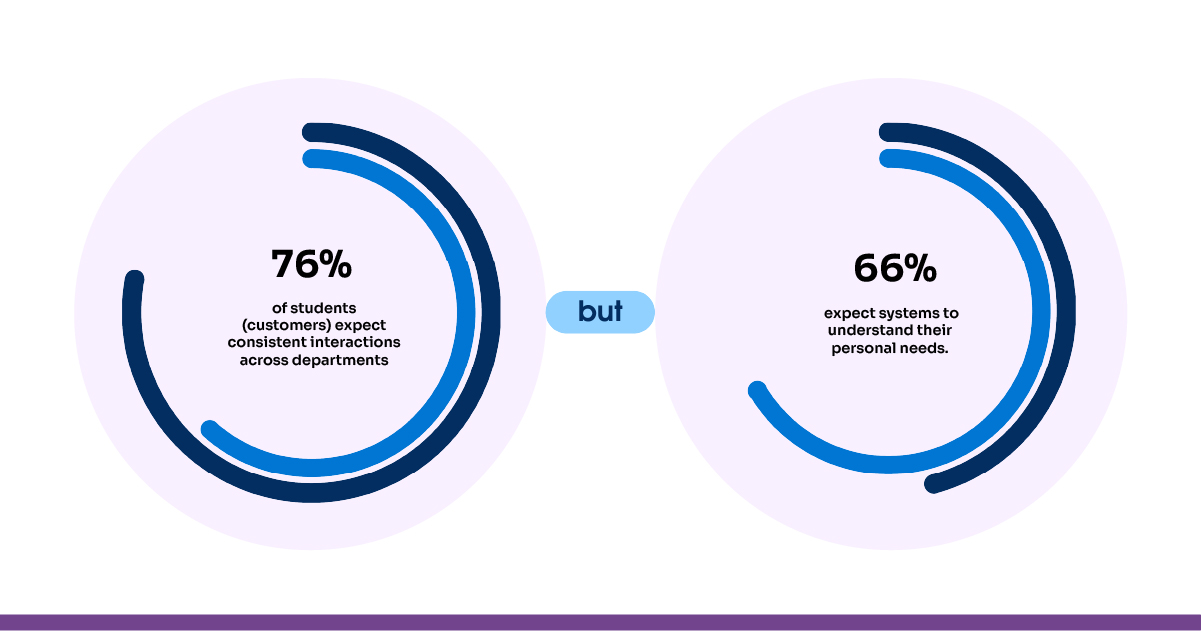
They want instant updates on applications, program recommendations based on their interests, and communication on platforms they use, such as WhatsApp, SMS, or even Instagram.
Just like top brands compete on experience, universities must deliver a seamless journey from inquiry to alumni status. A CRM makes this possible by tracking and optimising every student touchpoint, leading to higher conversions, stronger retention, and lifetime alumni value.
Read more: 6 Best CRM Tools for Automation: Features, Benefits, and Examples
Top 10 Features Every University CRM Should Have in 2025
Here’s a detailed list of the Top 10 Features Every University CRM Should Have in 2025, tailored specifically for higher education institutions navigating digital transformation, increasing competition, and evolving student expectations:
1. Centralised Student Lifecycle Management
A university CRM must manage the entire student journey—from lead generation and application to enrollment, student support, and alumni relations—all in one unified platform.
Why it matters: Avoids data silos across departments and ensures a consistent, personalised student experience.
2. Automated Lead Capture & Nurturing
Capture student inquiries from websites, ads, forms, and social media—then automatically nurture them with personalised emails, reminders, and SMS follow-ups.
Why it matters: Saves time and improves inquiry-to-application conversion rates.
3. Smart Segmentation & Personalisation
Segment prospects by interests, region, demographics, behaviour, or stage in the admissions funnel and deliver tailored messaging.
Why it matters: Personalised outreach enhances student engagement and increases response rates.
4. Multichannel Communication Tools
Communicate with students across email, SMS, WhatsApp, phone, live chat, and social media—all from one platform.
Why it matters: Students expect real-time, platform-flexible interaction.
5. Workflow & Process Automation
Automate repetitive tasks like follow-up emails, form reminders, fee payment nudges, and task assignments based on triggers.
Why it matters: Increases efficiency, reduces manual errors, and ensures no student falls through the cracks.
6. Real-Time Analytics & Reporting Dashboards
Track key metrics like inquiry-to-enrollment conversion, email open rates, campaign ROI, and student engagement using custom dashboards.
Why it matters: Data-backed decisions lead to more effective recruitment strategies.
7. Mobile Accessibility for Staff & Counsellors
Give your recruitment teams access to the CRM via mobile apps—so they can log notes, update statuses, and follow up with students during campus events, fairs, or travel.
Why it matters: Keeps teams productive and connected on the go.
8. Event & Campaign Management
Plan, promote, and track events like webinars, open houses, and virtual tours directly from the CRM, with automatic registration tracking.
Why it matters: Helps drive engagement and improves event ROI with integrated analytics.
9. Application & Document Tracking
Enable real-time monitoring of application status, document uploads, and outstanding requirements for both students and staff.
Why it matters: Reduces administrative queries and streamlines the admissions process.
10. Seamless Integrations with SIS, LMS, and Finance Tools
Integrate your CRM with Student Information Systems (SIS), Learning Management Systems (LMS), finance platforms, and email marketing tools.
Why it matters: Ensures data flow across departments for a 360-degree view of each student.
Read more: Best 15 CRMs for Student Admissions and Recruitment
Choosing the Best Higher Education CRM for Your College or University
Here are the top 6 CRMs dominating the U.S. higher education space—each offering unique strengths to support enrollment, retention, and student success.
1. Slate by Technolutions
Slate is the undisputed leader when it comes to higher education CRMs in the U.S. Tailored specifically for admissions and enrollment, Slate is used by over 1,400 colleges and universities, including top Ivy League institutions. It allows for highly customisable application workflows, communication automation, and event management.
Why Universities Use Slate by Technolutions
- Built exclusively for higher ed
- A centralised platform for applications, emails, and events
- Strong support community and user base
2. Salesforce Education Cloud
Salesforce Education Cloud brings the power of a global enterprise CRM to the academic world. With advanced customisation, AI-driven engagement, and a 360° student view, it supports everything from recruitment to alumni relations. Though not initially built for education, it has been deeply integrated into universities’ workflows via Education Cloud and partners like EDA (Education Data Architecture).
Why Universities Use Salesforce Education Cloud
- Highly customisable and scalable
- Powerful analytics and AI
- Enables institution-wide engagement across the student lifecycle
Read more: Salesforce for Higher Education: Benefits, Drawbacks, and How to Use It Effectively
3. HubSpot
HubSpot’s strength lies in its user-friendly interface, powerful marketing tools, and free CRM core, making it especially appealing for:
- Continuing education and extension programs
- Online and hybrid colleges
- Institutions focused on digital-first marketing
While it lacks the deep admissions workflows of Slate or Ellucian, it excels in content-driven student engagement and inbound lead generation.
Why Universities Use HubSpot:
- Powerful marketing automation: Email workflows, blogs, social media, and landing pages—all in one place.
- Ease of use: Designed for non-tech users and marketing teams.
- Affordability: Free tier available with affordable add-ons.
- Customisable CRM: Track prospective students, manage lists, and personalise outreach.
- Integrations: Works with tools like Zapier, Slate, Salesforce, and more.
4. Ellucian CRM Recruit
Ellucian CRM Recruit is part of Ellucian’s suite of tools and is a natural fit for institutions already using Ellucian’s ERP systems, like Banner or Colleague. It focuses on streamlining recruitment and admissions, giving institutions a single platform to manage leads, nurture prospects, and convert applicants.
Why Universities Use Ellucian CRM Recruit
- Seamless integration with Ellucian systems
- Designed specifically for higher education recruitment
- Strong data and workflow automation
5. TargetX
TargetX is a Salesforce-based CRM tailored for higher ed by Liaison, making it ideal for schools that want customizability with an education-first approach. It helps institutions handle everything from recruitment and application management to student engagement and retention strategies.
Why Universities Use TargetX
- Deep focus on student success and retention
- Combines Salesforce power with higher ed workflows
- Excellent for mid-sized universities and student-centric campuses
6. Element451
Element451 is an AI-driven CRM built specifically for higher education marketing and recruitment. It’s gaining rapid traction among small and mid-sized colleges for its smart automation, personalised messaging, and behavioural analytics that make communication more relevant and timely.
Why Universities Use Element451
- Powerful AI and behavioural targeting
Great user experience and automation tools - Budget-friendly for smaller institutions
Summary
In 2025, universities face declining enrollments, rising costs, and digitally savvy students demanding seamless experiences. CRM systems have become essential, with the global higher-ed CRM market projected to hit $10.8 billion by 2033. Institutions like Georgia State and LSU Online use CRMs to boost enrollment, improve engagement, and increase retention by 36%. These platforms personalise student journeys, automate communication, and streamline operations. Features like lead nurturing, multichannel messaging, and real-time analytics help universities stay competitive. Leading CRMs—Slate, Salesforce, HubSpot, Ellucian, and more—are now the backbone of modern higher education, driving efficiency, retention, and long-term student success.
Innovative products like EDMO’s Document Intelligence and Conversation Intelligence are essential for this transformation. Our Document Intelligence improves student engagement and speeds up enrollment by providing advanced data analysis and insights. Meanwhile, Conversation Intelligence enhances student interactions through AI-powered chatbots and voice assistants. These tools deliver real-time, personalised support across multiple channels, addressing everything from admissions inquiries to financial aid information. This automation ensures that students receive accurate information instantly, enhancing their overall experience and increasing institutional efficiency. As colleges face demographic challenges, adopting AI-driven solutions is becoming crucial. By embracing these technologies, institutions can improve student engagement, streamline administrative processes, and effectively meet the evolving needs of prospective and current students.
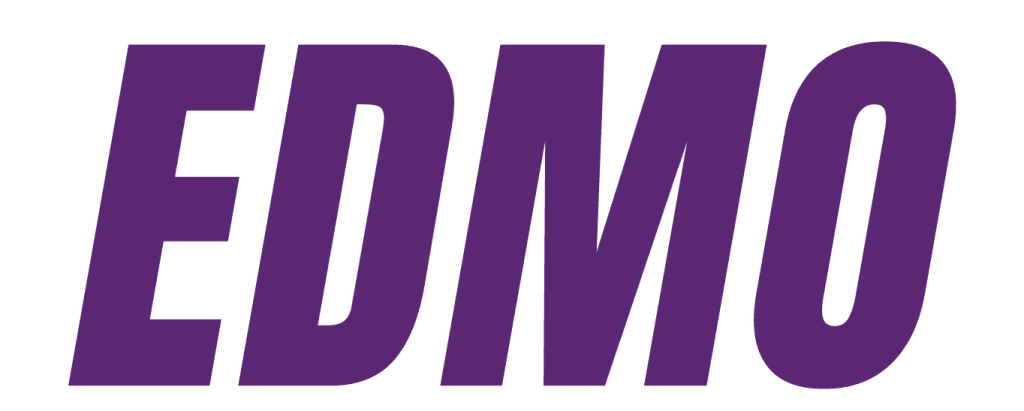
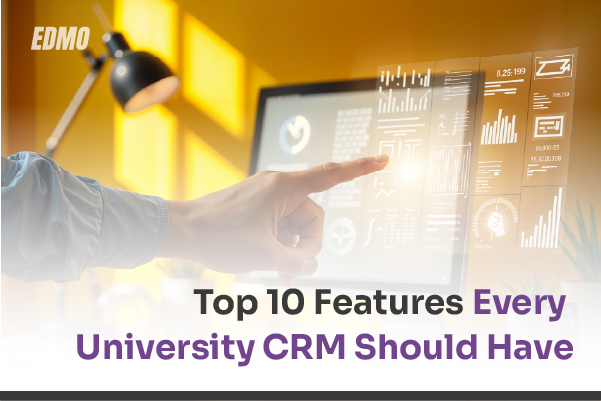
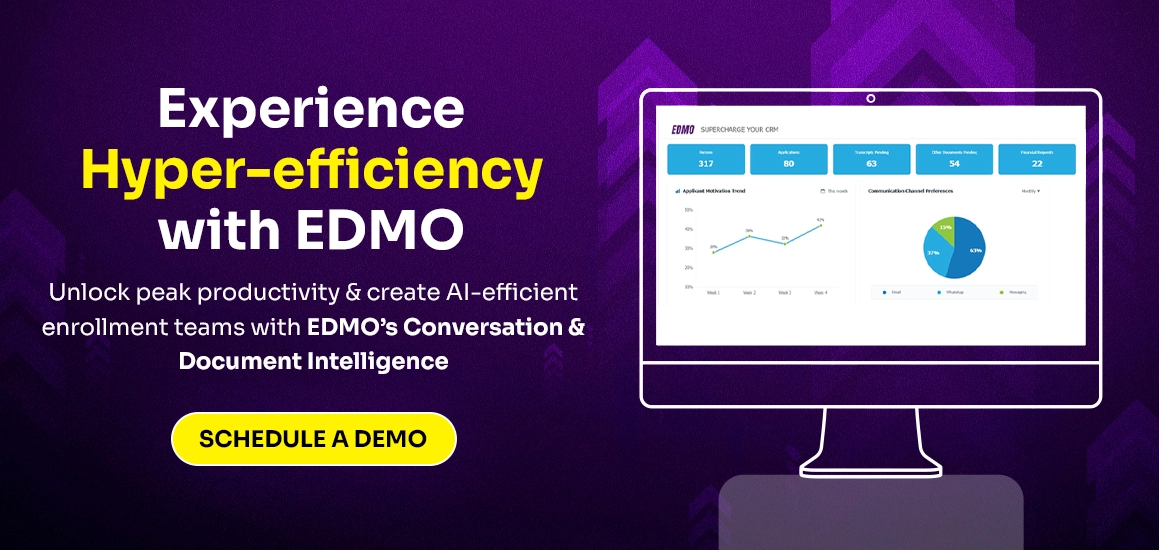





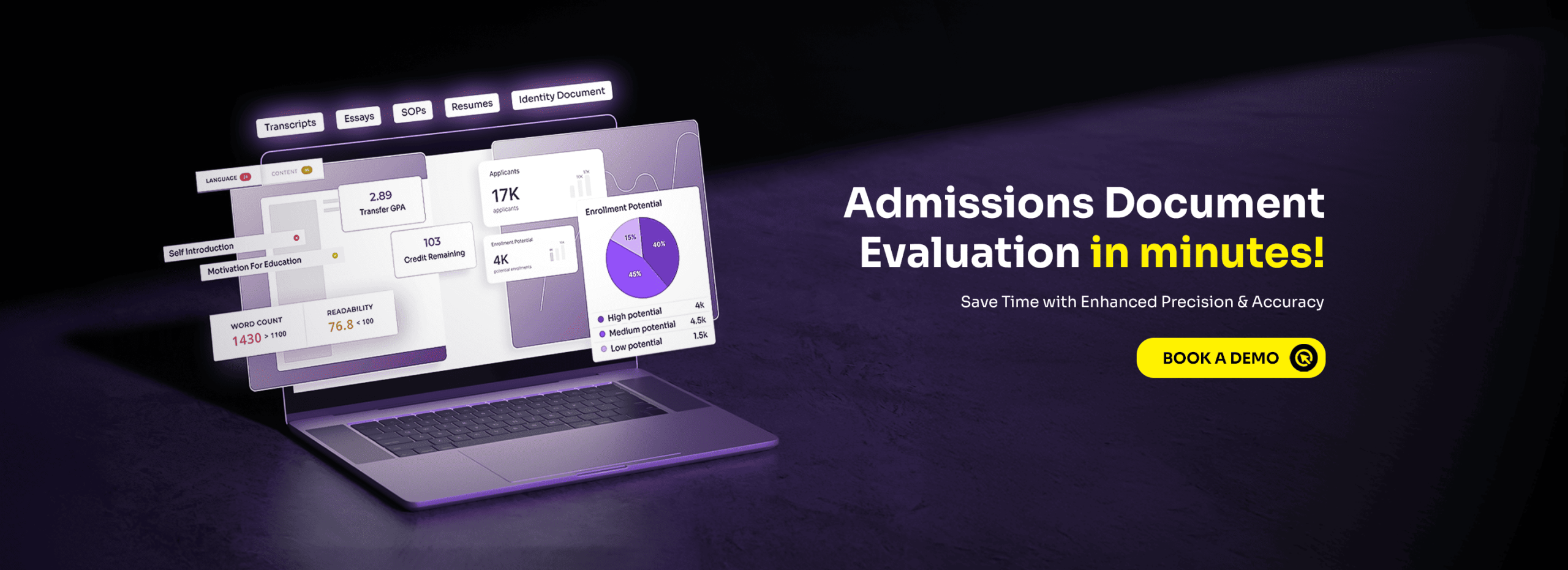
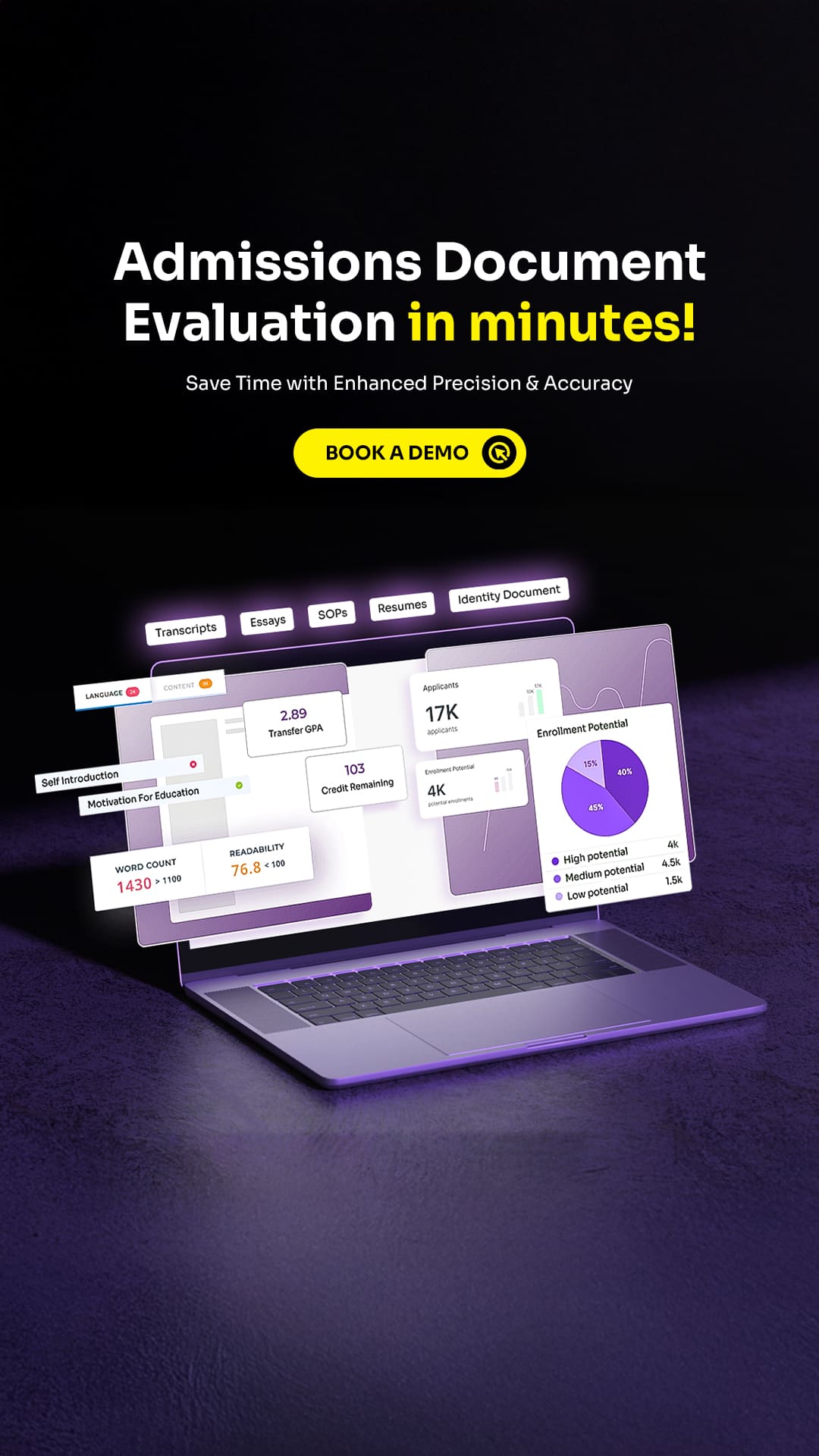
No comments yet. Be the first to comment!
Leave a Comment